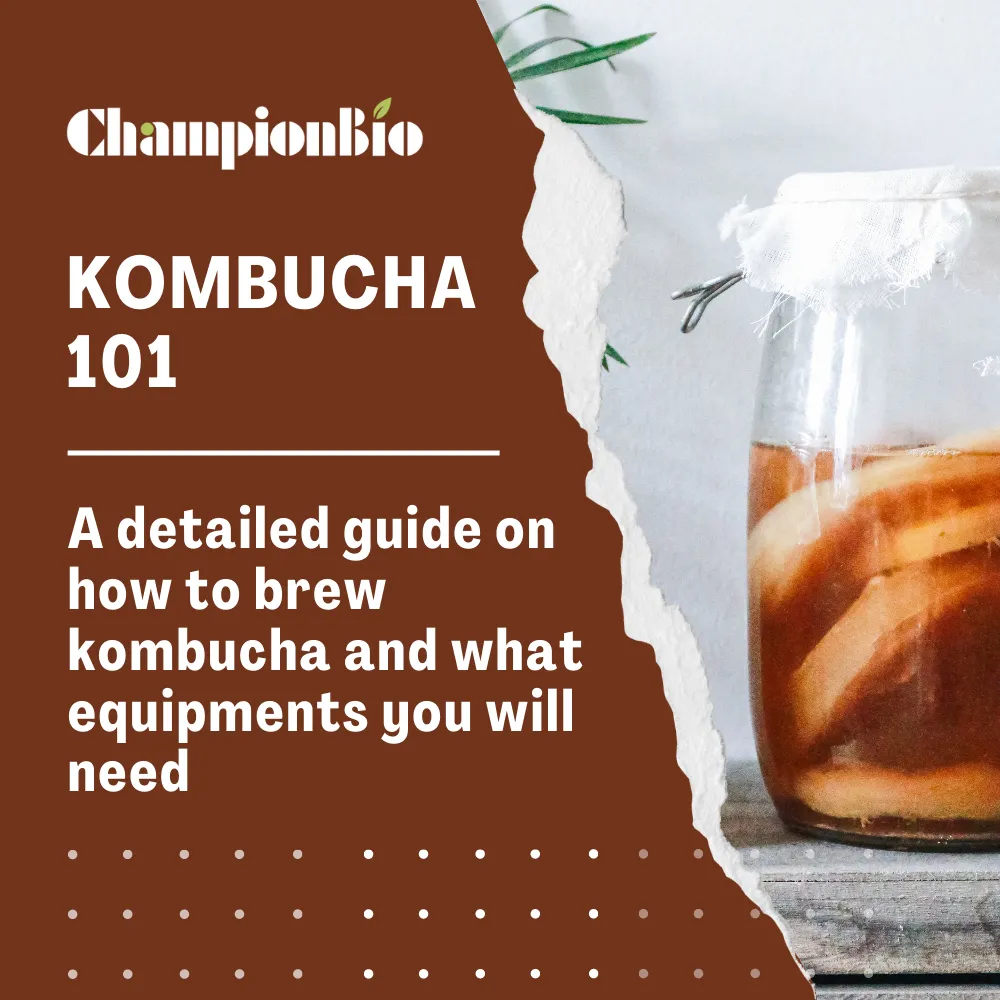Kombucha 101: A detailed guide on how to brew kombucha and what equipments you will need

What comes to your mind when you mention the word "kombucha"?
Kombucha is undoubtedly something you have seen in grocery stores, health food stores, and perhaps restaurants. This special kind of tea; mostly described as a functional drink that quenches thirst with sweet and sour notes; is helpful for digestive tract health care, metabolism promotion, smooth defecation and has many more benefits to count. Some people even refer to it as a "elixir of life" when praising this fizzy fermented tea's potential health advantages.
What is it, though, and how is it made? And from where can these health advantages originate?
The key is: kombucha fermentation.
But it’s not as simple as it sounds. Pre-preparation, bacteria cultivation, and fermentation processes are quite complicated...
Make homemade kombucha the first time!
If you are searching for ways to have a balanced diet, pursue a healthy gut and body, and love the sweet and sour taste of fermented food group, Kombucha is a refreshing drink that is just right for you. As part of its ingredients consist of natural probiotics, low sugar, and almost no caffeine, it is a trending drink with multiple health benefits.
Unfortunately, in most of the global markets, there are few affordable options for commercially available kombucha products. When it comes to kraft kombucha, however, the taste can vary and you may not get the same drink twice in the very same cafe. And it's unpleasant if your taste buds are quite sensitive and have standardized quality expectations.
Now the question is, just like many other fermented food & beverages, why not make our own Kombucha at home? To make Kombucha at home, you just need a little patience, plus this series of detailed practices to get advanced in your brewing skills and master kombucha brewing.
Remember the DIY kombucha recipe we mentioned in the What is Kombucha? Natural Fermented Probiotics for a Better Digestive Health ?
Tea (black tea, green tea, oolong tea) + bacterial film (SCOBY) + sugar + filtered water + starter liquid + fruit juice or natural flavor (optionally added)
Today we are going to derive from this formula, and start with black tea strains to prepare for our own hands Brewing, and avoiding the mistakes that both novice and veteran are prone to make in the process, so that you can succeed at the first DIY; as long as you can brew tea, it is not difficult to make kombucha!
Table of contents
- What kind of tea should I choose when making my own kombucha?
- Fermented kombucha is best with this sugar
- What is starter fluid? The brewing of kombucha with vinegar is smoother!
- Kombucha "Tea Mother" - SCOBY (Black Tea Mushroom, Kombucha)
- Container material: glass > ceramic > stainless steel
- Container size and diameter
- Container cover
- Other useful gadgets
In addition to being economical to brew kombucha at home, what’s even better is that you can start with the raw materials and carefully control each ingredient you drink. Therefore, in this series of kombucha DIY teaching, let's start with the preparation of ingredients!
What kind of tea should I choose when making my own kombucha?
The type of tea substrate selected will not only affect the cultivation of kombucha strains, but also affect the taste of the final fermented product.
If you are brewing for the first time, we recommend starting with the most basic black tea leaves (both tea bags or bulk tea). Sweet black tea with added sugar and bacteria has a slower fermentation speed. You can gradually familiarize yourself with the fermentation process and use black tea to brew it. The kombucha that comes out also has a milder flavor, which is more suitable for beginners to taste.
After brewing a few times, you can choose or mix different tea leaves according to your taste preference. For example, oolong tea with slightly floral and fruity aroma and semi-fermented oolong tea is also an easy-to-use option. While green tea is notFermented tea, you need to increase the amount of SCOBY when you brew it yourself, but green tea has higher polyphenol antioxidant and catechin content than other tea species. Others such as white tea, national treasure tea, and mate tea are also full of health benefits, suitable for those who are already proficient in each fermentation step to challenge early adopters!
Last but not least, no matter what kind of tea it is, please choose organic varieties as much as possible to avoid residues of pesticides or other chemical substances, otherwise it may hinder the smooth fermentation of kombucha strains!
Fermented kombucha is best with this sugar
To brew kombucha by yourself, you only need to use the most common sucrose, so that the yeast can quickly convert and decompose nutrients, which can effectively ensure the smooth fermentation process.
You might be thinking that since you're brewing your own kombucha, why not just make a sugar-free version with lower calories? Because sugar is the source of nutrition for kombucha, if you reduce sugar at will, you will be "starved" to kombucha, and naturally cannot be fermented into kombucha.
Of courseDon't worry about ingesting too much sugar, because in the subsequent fermentation process, more than 90% of the sugar will be converted and consumed. Compared with commercially available hand shakes, kombucha is still a low-sugar drink, with only a small amount of sugar. 1/10 the amount of orange juice. As for the type of added sugar, some people choose honey, brown sugar or unprocessed sucrose for health reasons. Although these sugars are less refined, they are prone to problems such as excessive yeast flavor in the finished product and even shortening the life of black tea strains, so they are not suitable for taking to brew kombucha.
What is starter fluid? The brewing of kombucha with vinegar is smoother!
The starting liquid is the tea soup taken from the brewing liquid in the previous batch of kombucha finished products, which contains rich yeast and acetic acid bacteria; the addition of the starting liquid should account for more than 10% of the whole sweet tea, so that the new kombucha can start to ferment .
And if you are brewing for the first time and you don't have a starter liquid on hand, you can use commercially available unflavored or essential oil-free kombucha instead.
Here I invite you to know this Manna-K Kombucha Concentrate . Adding it can not only effectively avoid bottle bursting, but also does not need to add additional starter liquid, so you can easily brew organic, high-quality kombucha.
Kombucha "Tea Mother" - SCOBY
Last but not least, kombucha is essential for brewing kombucha. If you don't have a kombucha membrane at hand, or if you don't know what kombucha is, please refer to our other kombucha introduction article first . The kombucha bacterial film used to make kombucha only needs to be purchased or obtained once, and then stored in the proper environment and nutritional conditions, and new bacterial film will continue to grow, which can be used continuously.
After preparing the ingredients, let's take a look at what utensils are used for DIY kombucha brewing, and how to choose the most suitable style. In fact, there are only two basic necessary tools for brewing kombucha: brewing container and container covering, but there are four points that need special attention when choosing:
Container material: glass > ceramic > stainless steel
Since kombucha is an acidic food with a low pH value (3.5~2.5), please try to avoid metal materials when choosing materials, otherwise it will cause corrosion and release harmful substances for a long time; even stainless steel containers should be evaluated for material grade , It is generally recommended that the grade of 304 or above is sufficient to resist the corrosion of organic acids.
A better material option would be glass, which is thick enough to withstand the pressure of carbonic acid, durable and resistant to acid and alkali, and is not easy to scratch after repeated use. In addition, there are food and plastic barrels made of No. 5 plastic PP (polypropylene), which are resistant to acid and alkali and heat (100-140 degrees), and will be another affordable choice for brewing containers.
Container size and diameter
You can brew kombucha by yourself, but don’t forget to reserve a space of [drinking amount + 20%] when purchasing a container. Don’t fill the container until it is full, so that the biofilm will have room to breathe and grow. In addition, when calculating the amount, in addition to the drinking amount this time, please also remember to include the starting liquid for the next brewing (about two glasses are filled).
The best brewing bottle is a wide-bore container, and the round can has a lower probability of breaking than a square bottle; but there is no need to choose a wide-mouth bottle, because the larger the diameter, the wider the surface area of the tea liquid in contact with the air. The faster the fermentation. Too fast a fermentation rate is difficult to master and can become too sour in just a few hours, ruining the taste of the fermented product.
Container cover
Since the acetic acid bacteria need oxygen for fermentation, during the kombucha production process, which lasts 7 to 30 days, the bottle cap must not be tightly closed, but a piece of breathable cloth should be used to cover the bottle mouth of the container, so as to avoid entrapment during brewing. Incoming fruit flies, bugs, or accidentally contaminated with dust raised indoors.
In terms of fabric selection, breathable cotton cloth or filter tea bags are the easiest to obtain and have good effects. Simply put a rubber band on the bottle and tighten the mouth of the bottle, which can ensure the cleanness of the tea liquid and the air circulation at the same time. Be careful not to use a covering that is too porous, such as gauze, or small creatures may burrow through the gap.
Other useful gadgets
In addition to the brewing vessel, there are a range of tools that can help make the process of fermenting your kombucha smoother, such as a mesh tea ball infuser. If you usually use loose tea leaves instead of tea bags, use with tea balls to avoid tea leaves. Floating everywhere. Using a filter or sieve (which can also be replaced with gauze) can make the process of taking out the SCOBY after fermentation more convenient, and can quickly filter out the sediment and yeast mycelium in the finished kombucha; but this is mainly For the sake of appearance, drinking them is actually completely harmless.
In addition, since the most suitable temperature range for brewing kombucha is between 22 and 28 degrees Celsius, if it is too cold, it will ferment weakly, and if it is too hot, it will ferment too quickly and too sour. Therefore, a sticky surface thermometer will be a good investment- ─With it, you can monitor the temperature of the tea liquid at any time, without having to use a cooking thermometer to measure it every time.
Now you have all the ingredients and utensils needed to brew kombucha. In the next DIY article , we will explain each production step in detail, and together we will make home-brewed kombucha that is safe to drink every day.
And if you are planning to commercialize mass production and build a brand of kombucha for sale, welcome to meet our exclusive agent Manna-K Kombucha Concentrate to easily brew organic high quality!
參考資料
- The Simple Guide to Kickass Kombucha
- How to make kombucha
- White Bear and Gray Rabbit. Micro-fermented life. Kombucha Little Knowledge Part3
- Nian Nian's Balanced Life
- HOW-TO VIDEO: HOW TO MAKE KOMBUCHA TEA
- Fermented beverages, the kombucha ecosystem
- The fermented drink that has been around for thousands of years: kombucha
- Kombucha Bible




















